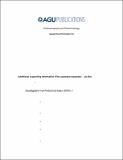Por favor, use este identificador para citar o enlazar a este item:
http://hdl.handle.net/10261/181776COMPARTIR / EXPORTAR:
 SHARE SHARE
 CORE
BASE CORE
BASE
|
|
| Visualizar otros formatos: MARC | Dublin Core | RDF | ORE | MODS | METS | DIDL | DATACITE | |

| Título: | Paleoproductivity in the SW Pacific Ocean During the Early Holocene Climatic Optimum |
Autor: | Bostock, H.; Prebble, J.G.; Cortese, Giuseppe; Hayward, B.W.; Calvo, Eva María CSIC ORCID ; Quirós-Collazos, Lucía CSIC ORCID; Kienast, Markus; Kim, K. | Fecha de publicación: | abr-2019 | Editor: | American Geophysical Union | Citación: | Paleoceanography and Paleoclimatology 34(4): 580-599 (2019) | Resumen: | The oceans are warming, but it is unclear how marine productivity will be affected under future climate change. In this study we examined a wide range of paleoproductivity proxies along a latitudinal transect (36–58°S) in the SW Pacific during the early Holocene climatic optimum, to explore regional patterns of productivity in a slightly warmer‐than‐present world. During the early Holocene there is a small increase in productivity in the subtropical waters, no change at the subtropical frontal zone, and conflicting evidence in records immediately south of the subtropical front, where an increase is inferred from one core site, but not at the other. Evidence for an increase in productivity in Antarctic Surface Waters, south of the polar front, is also equivocal. We infer a small increase in productivity in subtropical waters, and the ocean just south of the subtropical front was associated with changes in the ocean circulation of the SW Pacific, driven by changes in the Southern Hemisphere Westerly Winds split‐jet structure in this region. The relatively modest warming during the early Holocene climatic optimum in the SW Pacific indicates that this time period may provide an analog for future productivity for the midcentury (2055) under Intergovernmental Panel on Climate Change Representative Concentration Pathway 8.5 or for the end of the century (2100) under Representative Concentration Pathway 4.5. However, higher‐resolution, downscaled models, with realistic Southern Hemisphere Westerly Winds, will be necessary to forecast future productivity for this oceanographically complex region | Descripción: | 20 pages, 6 figures, 1 table, supporting information https://doi.org/10.1029/2019PA003574.-- The data from this paper will be available at the Pangaea.de database | Versión del editor: | https://doi.org/10.1029/2019PA003574 | URI: | http://hdl.handle.net/10261/181776 | DOI: | 10.1029/2019PA003574 | Identificadores: | doi: 10.1029/2019PA003574 issn: 2572-4517 |
| Aparece en las colecciones: | (ICM) Artículos |
Ficheros en este ítem:
| Fichero | Descripción | Tamaño | Formato | |
|---|---|---|---|---|
| Bostock_et_al_2019_postprint.pdf | 974,96 kB | Adobe PDF |  Visualizar/Abrir | |
| Bostock_et_al_2019_suppl.pdf | 202,81 kB | Adobe PDF |  Visualizar/Abrir | |
| Bostock_et_al_2019_suppl_table.xlsx | 653,81 kB | Microsoft Excel XML | Visualizar/Abrir |
CORE Recommender
SCOPUSTM
Citations
6
checked on 30-mar-2024
WEB OF SCIENCETM
Citations
6
checked on 26-feb-2024
Page view(s)
203
checked on 19-abr-2024
Download(s)
420
checked on 19-abr-2024
Google ScholarTM
Check
Altmetric
Altmetric
NOTA: Los ítems de Digital.CSIC están protegidos por copyright, con todos los derechos reservados, a menos que se indique lo contrario.
